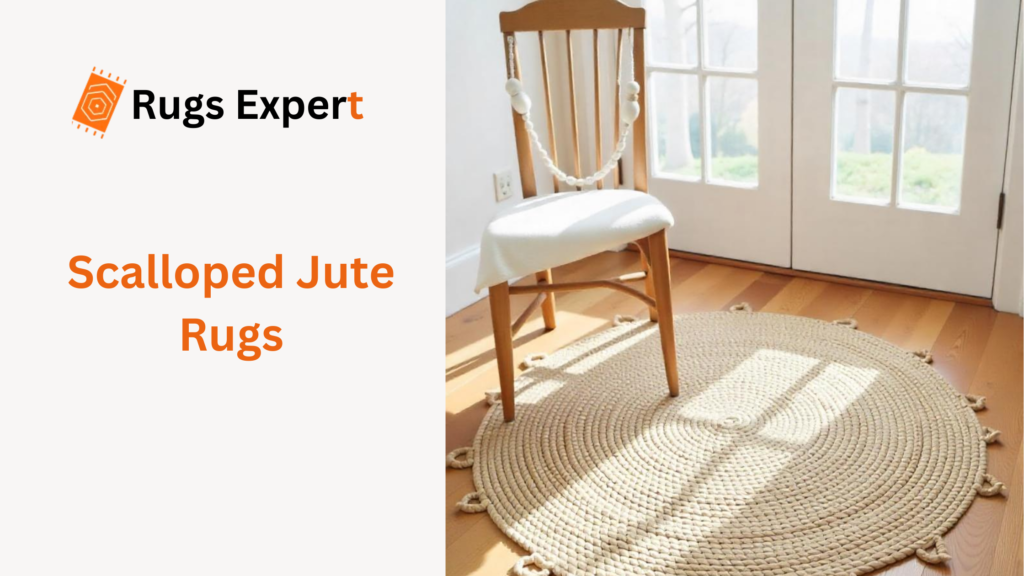
In the ever-evolving world of home décor, certain elements stand the test of time while adding a touch of contemporary charm. The scalloped jute rug is one such timeless piece that has gained significant popularity among interior designers and homeowners alike.
Whether you’re looking to bring a touch of nature indoors, searching for sustainable home décor options, or simply want to add texture and visual interest to your floors, scalloped jute rugs offer an excellent solution.
In this comprehensive guide, we’ll explore everything you need to know about these beautiful natural accent pieces, from their origins and benefits to styling tips and maintenance advice.
What Are Scalloped Jute Rugs?
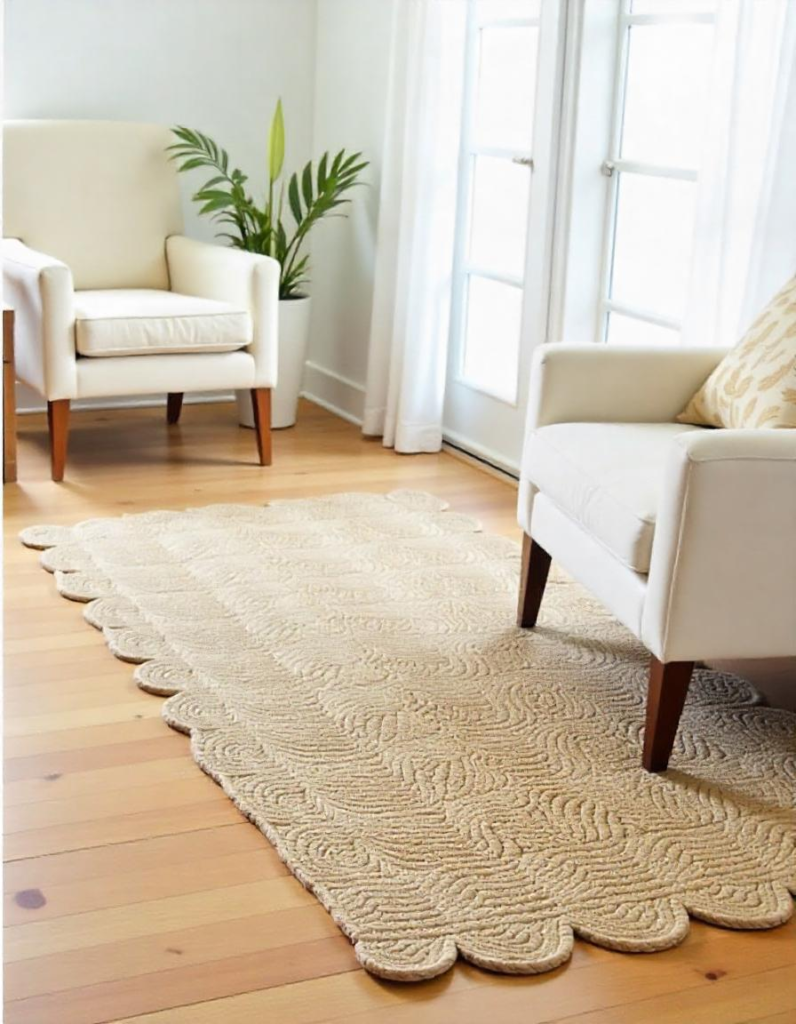
Scalloped jute rugs are floor coverings made from natural jute fibers featuring decorative scalloped edges that add a distinctive design element to the traditional jute rug. The scalloped edges create a soft, wave-like border around the perimeter of the rug, adding visual interest and a touch of elegance to an otherwise rustic material.
Jute itself is a natural plant fiber derived from the stems of the jute plant (primarily Corchorus olitorius and Corchorus capsularis), which grows abundantly in the warm and humid regions of Asia, particularly Bangladesh and India. According to the Food and Agriculture Organization, jute is one of the most affordable natural fibers and is second only to cotton in terms of production and variety of uses.
History of Jute:
The history of jute as a textile material dates back centuries, with evidence of jute cultivation found in the Indian subcontinent dating to ancient times. Traditionally used for making rope, sacks, and packaging materials, jute has evolved into a popular material for home décor items, with rugs being one of the most sought-after applications.
The scalloped edge design element adds a contemporary twist to these traditional fiber rugs. The scalloping technique involves creating curved or semi-circular patterns along the borders of the rug, giving it a softer, more decorative appearance compared to straight-edged alternatives. This distinctive feature transforms a simple jute rug into a design statement piece that can elevate the beauty of any room.
Benefits of Choosing Scalloped Jute Rugs
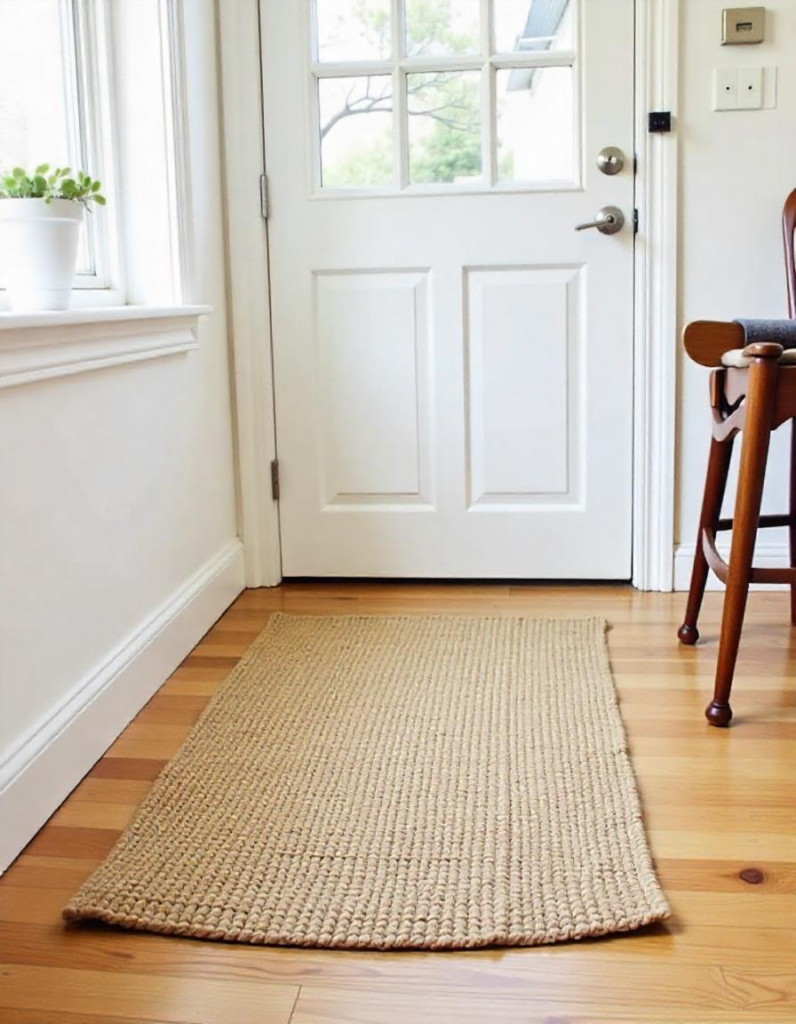
When considering floor covering options for your home, scalloped jute rugs offer numerous advantages that make them stand out from synthetic alternatives. Here’s why these natural fiber rugs deserve a place in your home:
Eco-Friendly and Sustainable
In an age where environmental consciousness is increasingly important, scalloped jute rugs represent an excellent sustainable choice for home décor. Jute is a renewable resource that grows quickly without requiring pesticides or fertilizers, making it an environmentally friendly option.
According to a study published in the Journal of Cleaner Production, jute production has a significantly lower environmental footprint compared to synthetic fiber production.
Additionally, jute rugs are biodegradable, meaning they won’t sit in landfills for centuries like their synthetic counterparts. This makes them an ideal choice for eco-conscious consumers.
Durability and Longevity
The natural strength of jute fibers results in rugs that maintain their appearance and structural integrity for years with proper care.The tight weaving techniques typically used in crafting scalloped jute rugs further enhance their durability.
The dense fiber construction creates a sturdy base that resists wear and tear, while the scalloped edges are often reinforced to prevent fraying. With reasonable care, a quality scalloped jute rug can serve as a beautiful floor covering for 5-8 years or more.
Unique Aesthetic Appeal
Scalloped jute rugs’ visual and tactile qualities set them apart from other floor coverings. The natural golden-brown color of jute fibers brings warmth and earthy elegance to any space, while the texture adds depth and dimension to your floors.
The scalloped edges elevate the design from basic to distinctive, creating a softening effect that contrasts beautifully with the rugged texture of the jute material. This juxtaposition of rustic and refined makes scalloped jute rugs particularly versatile design elements.
Versatility in Home Décor
Few floor coverings offer the versatility of scalloped jute rugs. Their neutral coloration and natural texture allow them to blend seamlessly with virtually any color scheme or decorating style. Whether your home features bold colors, subtle neutrals, modern furnishings, or antique treasures, a scalloped jute rug can serve as a unifying element that ties the room together.
These rugs work equally well as standalone statement pieces or layered beneath smaller decorative rugs for added texture and visual interest.
Hypoallergenic Properties
For households with allergy sufferers, scalloped jute rugs offer significant benefits. Unlike many synthetic rugs that can trap allergens and release volatile organic compounds (VOCs), jute is a naturally hypoallergenic material. It doesn’t harbor dust mites or attract pet dander to the same extent as some synthetic fibers.
Research from the Asthma and Allergy Foundation of America suggests that natural fiber floor coverings like jute can be better options for those with respiratory sensitivities.
Popular Styles and Designs of Scalloped Jute Rugs
Scalloped jute rugs come in various shapes, sizes, and designs to suit different spaces and aesthetic preferences. Understanding the range of options available can help you select the perfect rug for your home.
Round Scalloped Jute Rugs
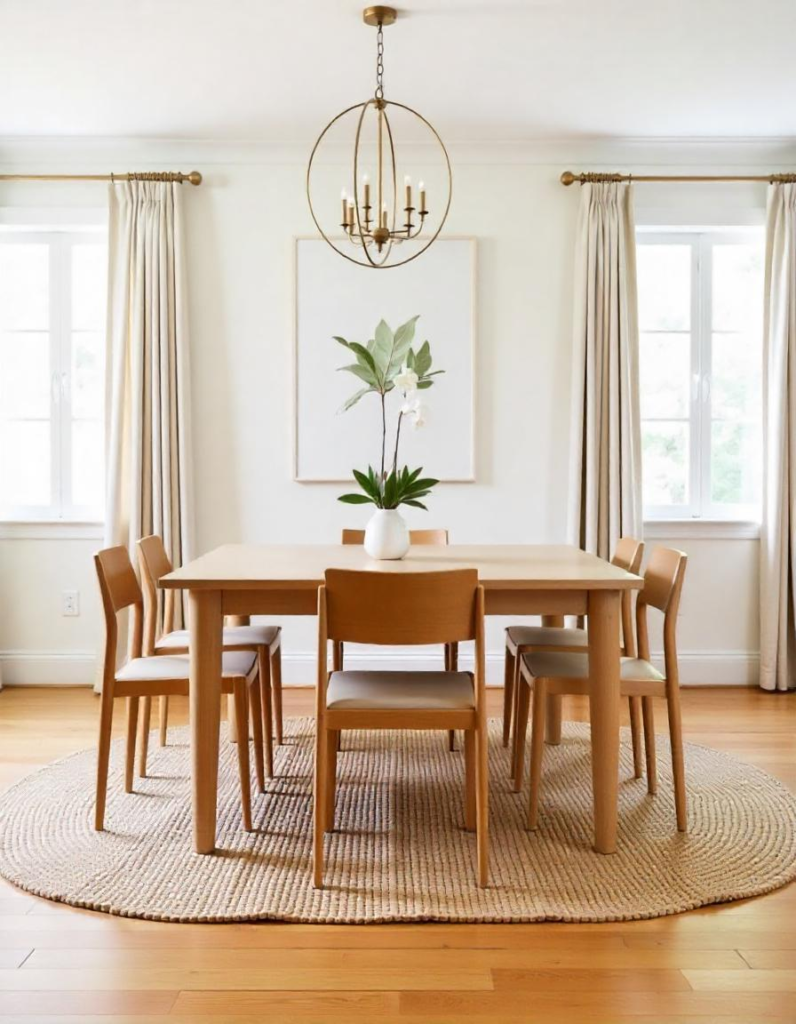
Round scalloped jute rugs are perhaps the most popular variety, with their circular shape beautifully complemented by the scalloped edge detail. These rugs create a soft, flowing appearance that works particularly well in:
- Smaller spaces where sharp corners might make the area feel cramped
- Beneath round dining tables to echo the circular shape
- Entryways and foyers to create a welcoming focal point
- Children’s rooms, where the absence of sharp corners is a practical advantage
Round scalloped jute rugs typically range from 3 feet to 8 feet in diameter, with 5-foot and 6-foot options being the most versatile for average-sized rooms.
Rectangular Scalloped Jute Rugs
Rectangular scalloped jute rugs offer a more traditional rug shape enhanced by the decorative scalloped border. These rugs provide excellent coverage for larger areas and are particularly well-suited for:
- Living rooms, where they can define the seating area
- Dining rooms, especially under rectangular tables
- Bedrooms, where they can frame the bed and provide a soft landing for bare feet
- Hallways, when sized appropriately for the space
The contrast between the straight lines of the rectangle and the curved, scalloped edges creates an interesting visual dynamic that adds character to your floors. Rectangular, scalloped jute rugs come in various sizes, from small 2′ x 3′ accent rugs to large 9′ x 12′ room-defining pieces.
Oval Scalloped Jute Rugs
Combining elements of both round and rectangular designs, oval scalloped jute rugs offer a unique middle ground. Their extended shape provides good coverage like rectangular rugs, while their rounded ends create a softer appearance. Oval scalloped jute rugs work wonderfully in:
- Narrow living spaces where a rectangular rug might emphasize the room’s dimensions
- Beneath oval dining tables for a coordinated look
- Transitional spaces like entryways that flow into hallways
- Offices and studies as a sophisticated foundation piece
The oval shape with scalloped edges creates a gentle, flowing aesthetic that can help soften rooms with many angular elements or furniture pieces.
Pattern and Color Variations
While natural jute offers beautiful texture and warmth in its unaltered state, scalloped jute rugs are also available with various patterns and color enhancements:
- Border designs: Some scalloped jute rugs feature contrasting borders in colors like black, navy, or cream
- Woven patterns: Subtle geometric patterns can be incorporated into the weave
- Bleached or dyed jute: Some manufacturers offer lightened or colored jute for different aesthetic effects
- Printed designs: Modern printing techniques allow for patterns to be applied to the surface of jute rugs
These variations maintain the natural benefits of jute while offering additional design possibilities to match your specific décor needs.
Size Options Available
Scalloped jute rugs come in a wide range of sizes to accommodate various spaces. Common dimensions include:
| Shape | Small | Medium | Large | Extra Large |
| Round | 3′ | 5′-6′ | 8′ | 10′ |
| Rectangular | 2’x3′ | 5’x8′ | 8’x10′ | 9’x12′ |
| Oval | 3’x5′ | 5’x7′ | 7’x9′ | 9’x12′ |
When selecting the appropriate size for your space, interior designers generally recommend choosing a rug that allows for at least 18-24 inches of floor space between the rug’s edge and the walls. For dining areas, the rug should extend at least 24 inches beyond all sides of the table to accommodate chairs.
How to Style Scalloped Jute Rugs in Different Rooms
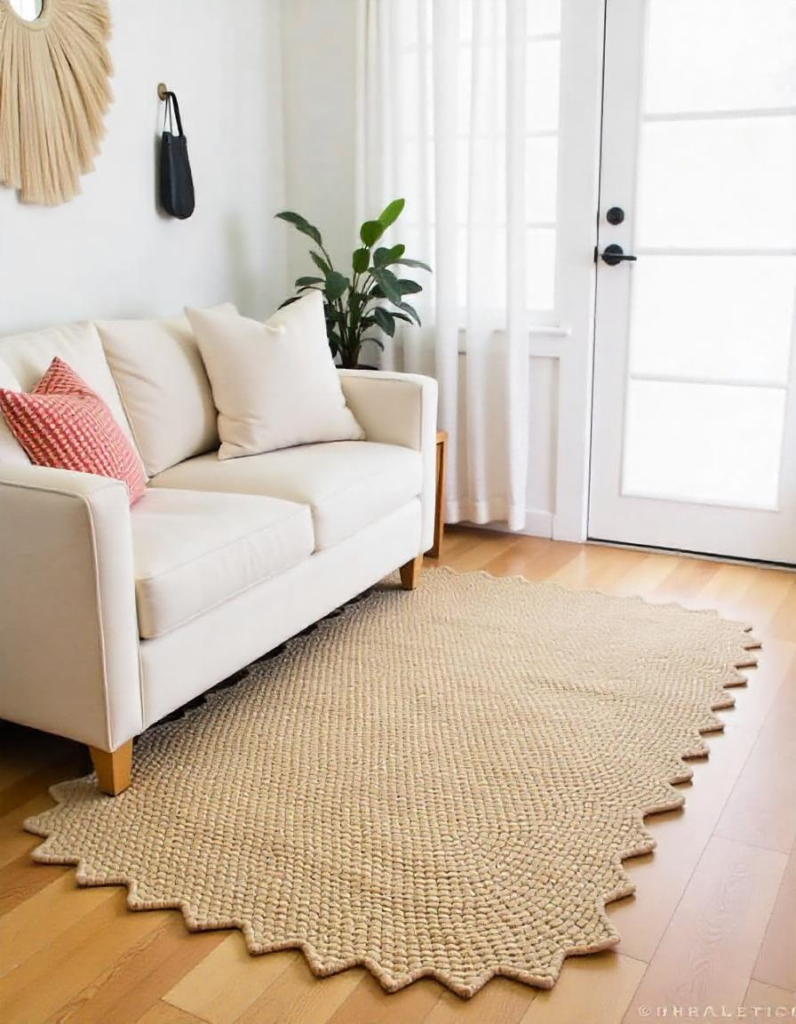
The versatility of scalloped jute rugs makes them suitable for virtually any room in your home. Here’s how to make the most of these natural floor coverings throughout your living spaces:
Living Room Styling Ideas
The living room is often the heart of the home and a perfect showcase for a beautiful scalloped jute rug. Consider these styling approaches:
Centerpiece Placement: Position a large scalloped jute rug (8’x10′ or larger) in the center of your seating area, ensuring all furniture legs either rest completely on the rug or completely off it for a balanced look. This creates a unified conversation area and anchors the room’s design.
Layered Look: For a more bohemian or eclectic style, layer a smaller patterned rug over your scalloped jute rug. The natural texture of the jute provides a neutral base that allows the top layer to shine while adding depth and dimension to your floor design.
Complementary Textures: Pair your scalloped jute rug with furnishings in complementary natural materials like wood, leather, or linen for a cohesive organic aesthetic. The contrast between smooth and textured surfaces creates visual interest throughout the space.
Bedroom Placement and Combinations
In the bedroom, a scalloped jute rug can add warmth and comfort while enhancing the room’s overall design:
Under-Bed Placement: A large rectangular scalloped jute rug positioned under the bed with at least 18-24 inches extending beyond the sides and foot creates a soft landing space and defines the sleeping area. For queen beds, consider an 8’x10′ rug, while king beds typically require a 9’x12′ size.
Bedside Runners: For a different approach, place smaller runner-style, scalloped jute rugs on either side of the bed rather than a single large rug underneath. This creates a symmetrical look while providing comfort underfoot when getting in and out of bed.
Dressing Area Definition: A round scalloped jute rug can beautifully define a dressing area or reading nook within a larger bedroom, creating a visual separation of spaces without physical barriers.
Dining Room Arrangements
Scalloped jute rugs can add warmth and style to dining spaces while being practical for regular use:
Table and Chair Accommodation: Select a scalloped jute rug large enough to accommodate your dining table and chairs, even when the chairs are pulled out. Generally, the rug should extend at least 24 inches beyond the table on all sides.
Shape Coordination: Match the shape of your scalloped jute rug to the shape of your dining table for a harmonious look round rugs for round tables, rectangular rugs for rectangular tables, and oval rugs for oval tables.
Protection Measures: Consider adding a clear vinyl rug protector under dining chairs to prevent excessive wear from chair movement and protect against food spills in this high-risk area.
Interior designer and HGTV host Emily Henderson recommends jute rugs in dining areas because “they hide crumbs well and have enough texture to disguise minor stains that are inevitable in eating areas.”
Entryway and Hallway Options
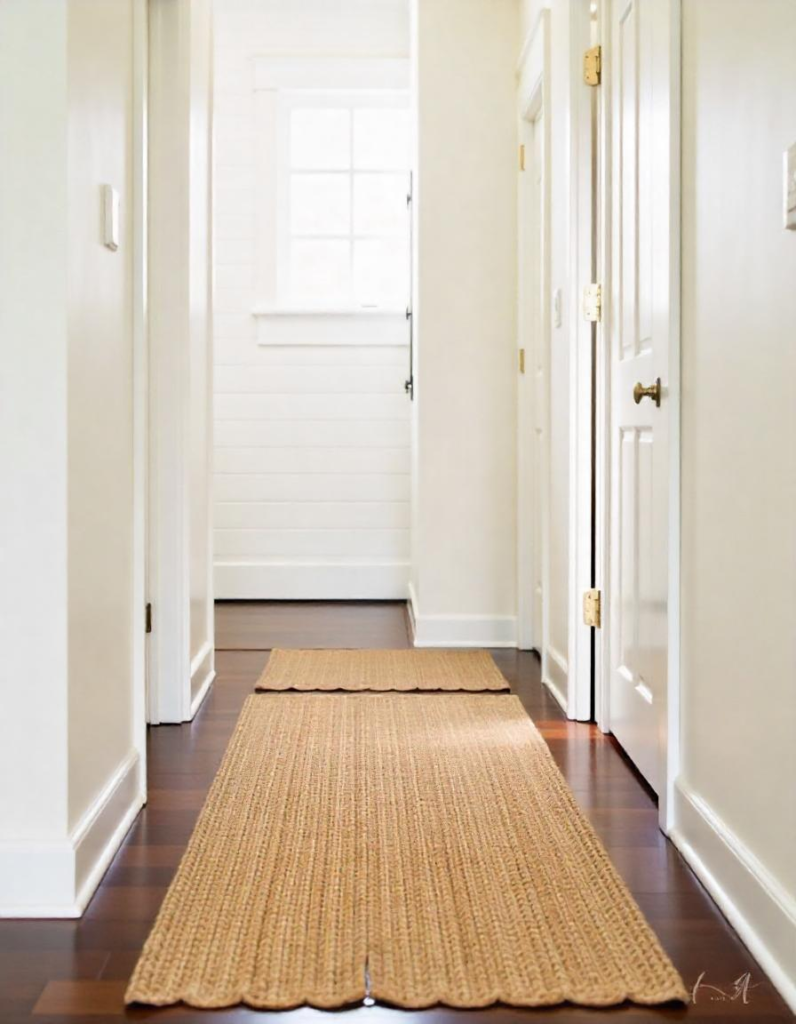
First impressions matter, and a scalloped jute rug can make your entryway both welcoming and practical:
Entryway Statement: A round scalloped jute rug in an entryway creates an immediate visual impact and helps define the transition space between outdoors and in. The durable nature of jute makes it suitable for this high-traffic area.
Also Read: Best Runner Rugs for Entryway: A Complete Guide
Hallway Runners: Long, narrow scalloped jute runners work beautifully in hallways, adding texture and warmth to these transitional spaces. Ensure the runner is centered in the hallway with equal floor space visible on both sides.
Layered Door Mats: Place a small scalloped jute rug over a more utilitarian door mat for a stylish approach to entryway floor coverings that still provides practical functionality.
Home Office Integration
Create a productive yet comfortable home office environment with the strategic use of scalloped jute rugs:
Desk Area Definition: Position a medium-sized scalloped jute rug under your desk and chair, ensuring it’s large enough to accommodate the chair’s movement. This not only protects your flooring but also creates a defined workspace within a larger room.
Acoustic Benefits: The natural texture of jute can help absorb sound in home office spaces, reducing echo and creating a more pleasant acoustic environment for video calls and concentration.
Warm Professional Aesthetics: The natural, earthy qualities of jute create a professional yet welcoming atmosphere, striking the perfect balance for a home office that’s both functional and inviting.
Caring for Your Scalloped Jute Rug
To ensure your scalloped jute rug remains beautiful and functional for years to come, proper maintenance is essential. Here’s how to care for this natural floor covering:
Regular Maintenance Tips
Incorporating simple maintenance practices into your routine can significantly extend the life of your scalloped jute rug:
Regular Vacuuming: Vacuum your scalloped jute rug at least once a week using a suction-only setting (no beater bar or rotating brush) to remove dust and prevent it from settling deep into the fibers. Vacuum both sides of the rug when possible.
Also Read: Best Vacuum for Wood Floors and Area Rugs: Which One is Right for You?
Also Read: 6 Best Vacuum for Oriental Rugs: Complete Buyer’s Guide (2025)
Rotate Periodically: Every 3-6 months, rotate your scalloped jute rug 180 degrees to promote even wear, especially in high-traffic areas.
Shake Out When Possible: For smaller scalloped jute rugs, take them outside periodically and shake vigorously to remove dust and debris that vacuuming might miss.
Address Shedding: New jute rugs often shed initially. Regular vacuuming will help minimize this natural process as the rug settles.
Cleaning Methods and Products

When deeper cleaning is necessary, follow these guidelines to avoid damaging your scalloped jute rug:
Spot Cleaning: For small stains or spills, blot immediately with a clean, white cloth to absorb as much liquid as possible. Then, mix a small amount of mild dish soap with water, apply sparingly to the affected area with a soft brush or cloth, and blot dry. Avoid saturating the rug.
Dry Cleaning: For overall cleaning, dry cleaning methods are safest for jute. Use dry cleaning powders specifically formulated for natural fiber rugs, following the manufacturer’s instructions carefully.
Professional Cleaning: For valuable or heavily soiled rugs, professional cleaning by specialists experienced with natural fibers is recommended. The Carpet and Rug Institute can help you locate qualified professionals in your area.
Cleaning Products to Avoid: Never use bleach, harsh chemicals, or steam cleaning on jute rugs, as these can damage the fibers and cause discoloration or weakening of the material.
Dealing with Stains and Spills
Quick action is crucial when accidents happen:
Immediate Blotting: Blot spills immediately with clean, white cloths or paper towels to absorb as much liquid as possible.
Dry Ingredients First: For many stains, beginning with dry absorbent materials like baking soda, cornstarch, or salt can help draw out moisture before any wet cleaning methods are attempted.
Mild Solutions Only: If further cleaning is needed, use only mild, natural cleaning solutions like diluted dish soap or white vinegar mixed with water.
Minimize Moisture: Keep water use to an absolute minimum when cleaning jute, as excessive moisture can lead to mildew or fiber damage. After any wet cleaning, ensure the rug dries completely and quickly, using fans if necessary.
Storage Recommendations
When your scalloped jute rug needs to be stored:
Clean Thoroughly: Always clean your rug before storage to prevent stains from setting and to deter pests.
Roll, Don’t Fold: Roll your scalloped jute rug around a sturdy cardboard tube rather than folding it to prevent creases and fiber damage.
Wrap Properly: Wrap the rolled rug in breathable cotton or muslin fabric, then secure with cotton twine. Avoid plastic wrapping, which can trap moisture.
Elevate: Store the rolled rug off the ground in a cool, dry place. Avoid damp basements or hot attics, as extreme temperatures and humidity can damage natural fibers.
Extending the Lifespan of Your Jute Rug

These additional practices can help maximize the longevity of your scalloped jute rug:
Use Rug Pads: Place a high-quality rug pad under your scalloped jute rug to prevent slipping, provide cushioning, and reduce wear from friction against the floor.
Also Read: The Best Area Rug Pad for Wood Floors: A Buyer’s Guide
Also Read: Say Goodbye to Slipping Rugs! Best Rug Pads for Concrete Floors
Limit Direct Sunlight: Position your scalloped jute rug away from areas of prolonged direct sunlight, as UV rays can cause fading and fiber weakening over time.
Control Humidity: Maintain moderate humidity levels in rooms with jute rugs. Excessively dry conditions can make fibers brittle, while high humidity can promote mold growth.
Address Edges Promptly: If you notice fraying along the scalloped edges, have them repaired promptly to prevent further unraveling.
Comparing Scalloped Jute Rugs to Other Natural Fiber Rugs
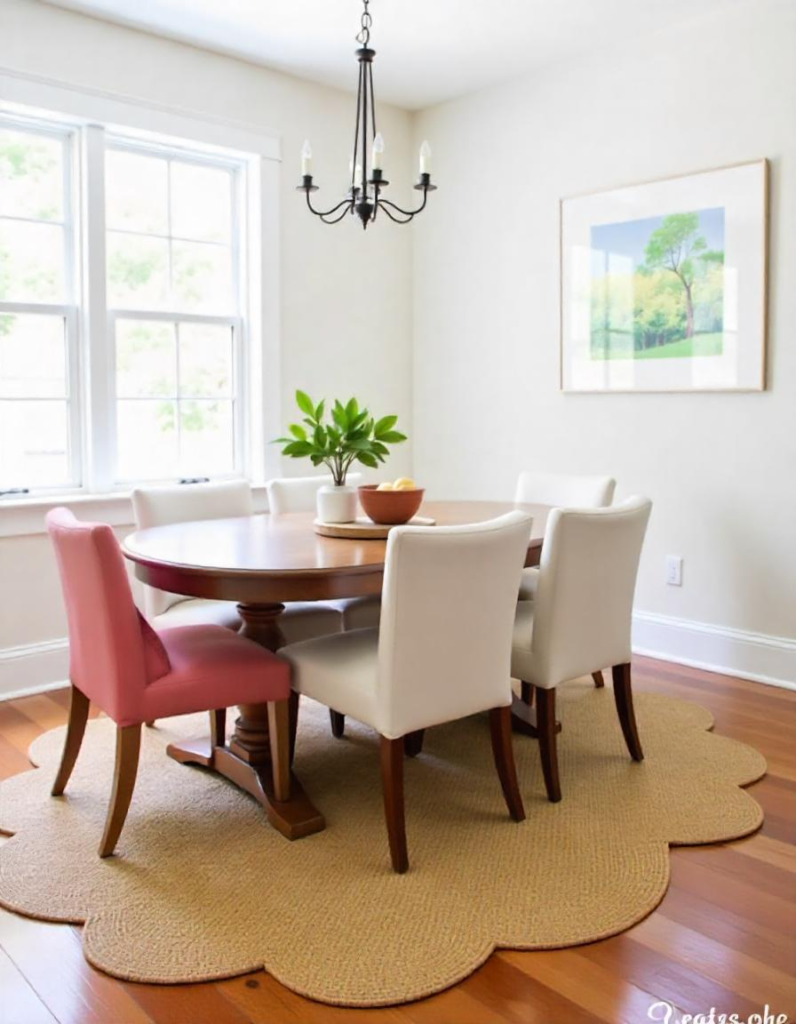
To make an informed decision about whether a scalloped jute rug is right for your home, it’s helpful to understand how jute compares to other natural fiber options:
Jute vs. Sisal Rugs
Texture and Feel: Jute offers a softer, more comfortable underfoot experience compared to sisal, which tends to be more rigid and rough. The scalloped edges of jute rugs further enhance their soft appearance compared to typically straight-edged sisal options.
Durability: Sisal generally outperforms jute in terms of durability and resistance to wear, making it more suitable for extremely high-traffic areas. However, jute’s softer texture makes it more comfortable in living spaces and bedrooms.
Moisture Resistance: Neither material excels in damp environments, but sisal has slightly better moisture resistance than jute. However, both should be avoided in bathrooms, kitchens, or damp basements.
Appearance: Jute typically has a more golden, warm tone compared to sisal’s more neutral, wheat-like coloration. The scalloped edges available on jute rugs add a decorative element not commonly found in sisal rugs.
Jute vs. Seagrass Rugs
Water Resistance: Seagrass is naturally more water-resistant than jute, making it somewhat better suited to areas with higher humidity or occasional spills. However, neither material is fully waterproof.
Texture and Appearance: Jute has a softer, more varied texture compared to seagrass, which typically has a more uniform, smooth surface. Scalloped jute rugs offer decorative edge options not typically available in seagrass rugs.
Stain Resistance: Seagrass has natural oils that make it more stain-resistant than jute, which can be more absorbent and prone to staining. This makes seagrass potentially better for dining areas, while scalloped jute rugs excel in living rooms and bedrooms.
Flexibility: Jute is more flexible and can be crafted into various shapes and designs, including the distinctive scalloped edges, while seagrass is typically limited to simpler, more rigid constructions.
Jute vs. Cotton Rugs
Softness: Cotton rugs are generally softer than jute, making them particularly comfortable in bedrooms and bathrooms. However, jute offers better durability while still providing reasonable comfort.
Cleaning Ease: Cotton rugs are typically machine washable, making them easier to clean thoroughly than jute rugs, which require more careful cleaning methods.
Environmental Impact: Both materials are natural and biodegradable, but jute generally requires fewer resources to grow and process, potentially giving it a slight edge in environmental friendliness, according to research from the Environmental Protection Agency.
Visual Impact: Cotton rugs often feature more color varieties and printed patterns, while jute rugs, including scalloped varieties, offer more textural interest and a natural, earthy aesthetic.
Price Comparison Table

Understanding the cost differences between natural fiber rugs can help you make budget-conscious decisions:
| Rug Type | Small (3’x5′) | Medium (5’x8′) | Large (8’x10′) | Extra Large (9’x12′) |
| Scalloped Jute | $40-$100 | $80-$250 | $150-$400 | $200-$600 |
| Sisal | $60-$150 | $100-$300 | $200-$500 | $300-$700 |
| Seagrass | $50-$120 | $90-$280 | $180-$450 | $250-$650 |
| Cotton | $30-$90 | $60-$200 | $120-$350 | $180-$500 |
Note: Prices are approximate retail ranges and may vary based on quality, brand, and specific design features.
Pros and Cons Analysis
To help you determine if a scalloped jute rug is the right choice for your space, consider this comprehensive pros and cons assessment:
Scalloped Jute Rug Pros:
- Natural, eco-friendly material
- Distinctive decorative scalloped edges
- Softer underfoot than many other natural fibers
- Neutral coloration complements most decor styles
- Adds wonderful texture and visual interest
- Generally more affordable than sisal or seagrass
- Biodegradable at the end of its lifecycle
Scalloped Jute Rug Cons:
- Less durable than sisal or seagrass in high-traffic areas
- More susceptible to staining than synthetic alternatives
- Not suitable for damp environments
- Requires careful cleaning techniques
- May shed initially
- Can be damaged by excessive moisture
Also Read: The Best Rugs for High Traffic Areas and Pets That Are Easy to Clean
Where to Buy Quality Scalloped Jute Rugs
Finding the perfect scalloped jute rug for your home involves knowing where to shop and what to look for in terms of quality:
Top Online Retailers
The internet offers numerous options for purchasing scalloped jute rugs:
Wayfair: Offers a wide selection of scalloped jute rugs in various sizes, shapes, and price points. Their detailed product descriptions and customer reviews can help you make informed decisions.
Pottery Barn: Known for higher-quality home goods, Pottery Barn offers designer scalloped jute rugs with excellent craftsmanship, though at premium prices.
Rugs USA: Features a large inventory of scalloped jute rugs at competitive prices, with frequent sales and promotions.
Amazon: Provides access to numerous brands and styles of scalloped jute rugs, often with competitive pricing and fast shipping options.
Etsy: For unique, handcrafted, or vintage scalloped jute rugs, Etsy connects you with independent artisans and sellers worldwide.
Specialty Home Décor Stores
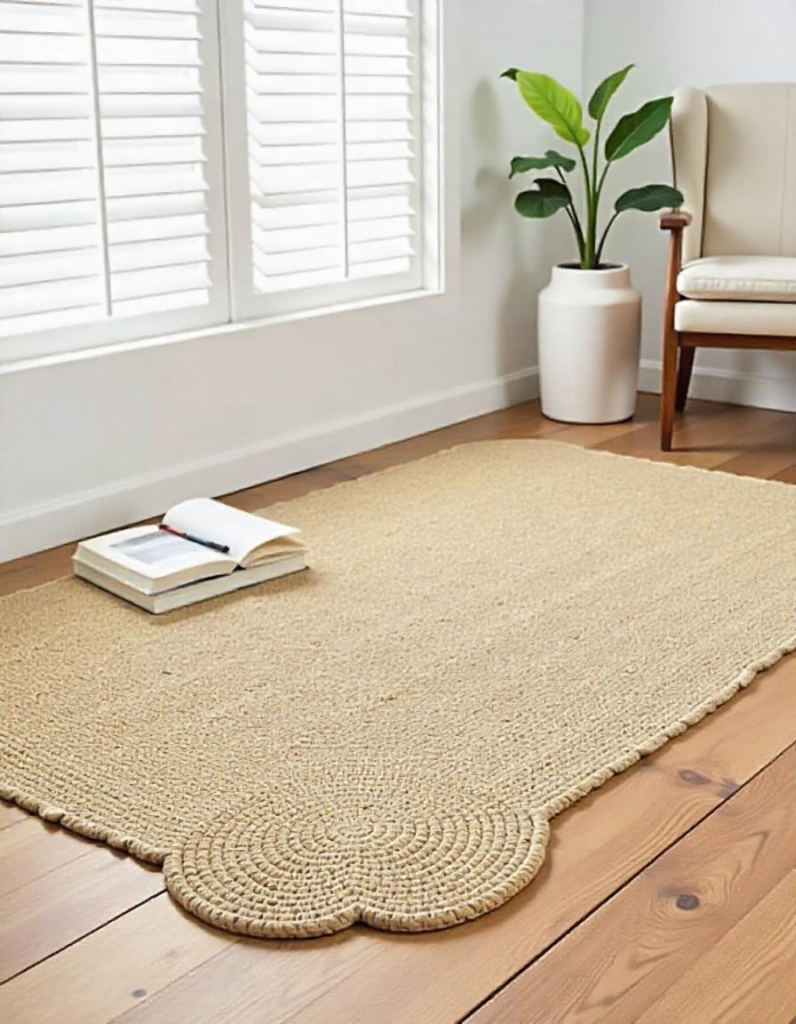
For those who prefer to see and feel their rugs before purchasing:
World Market: Offers a curated selection of globally inspired home goods, including scalloped jute rugs at reasonable price points.
West Elm: Features modern, design-forward, scalloped jute rugs with an emphasis on sustainable materials and ethical production.
HomeGoods/TJ Maxx/Marshalls: These discount retailers often carry brand-name, scalloped jute rugs at significant markdowns, though inventory varies by location and over time.
Local Carpet and Rug Specialists: Independent retailers specializing in floor coverings often offer expert advice and installation services, though prices may be higher than online options.
What to Look for When Purchasing
To ensure you’re getting a quality scalloped jute rug:
Weave Density: Look for tight, consistent weaving throughout the rug. Higher density indicates better quality and durability.
Edge Finishing: Examine the scalloped edges for secure stitching and even curves. Well-crafted edges will maintain their shape over time.
Backing Material: Check if the rug has a backing material. Quality scalloped jute rugs often feature cotton or canvas backing for additional stability.
Thickness and Weight: Heavier, thicker rugs typically indicate higher quality and will lie flat more easily on your floor.
Natural Variations: Expect some color variations in natural jute. Consistent coloration throughout might indicate artificial dyes or treatments.
Return Policy: Given the natural variations in jute, a generous return policy is important in case the rug doesn’t look as expected in your space.
DIY Tips for Customizing Your Scalloped Jute Rug
Personalize your scalloped jute rug to perfectly match your home’s aesthetic with these creative customization ideas:
Simple Decoration Ideas
Add personal flair to your scalloped jute rug with these straightforward enhancements:
Fabric Trim: Sew decorative fabric trim along the scalloped edges to add color or pattern. Choose washable fabrics that complement your existing décor.
Pom-Pom Embellishments: Attach small pom-poms along the scalloped edges for a playful, bohemian look perfect for children’s rooms or casual spaces.
Stenciled Patterns: Use fabric paint and stencils to add simple geometric patterns or motifs to your jute rug. Focus on the corners or create a border design for subtle enhancement.
Rope Outlines: Stitch decorative rope along the inner line of the scalloped edges to emphasize the curved design and add textural contrast.
Color Enhancement Techniques
If you want to modify the natural color of your scalloped jute rug:
Natural Dyes: Experiment with plant-based dyes like tea, coffee, or turmeric for subtle color modifications that maintain the rug’s natural character. Note that jute absorbs dye unevenly, which can create an attractive variegated effect.
Fabric Paint: Use fabric paint specifically formulated for natural fibers to add color to selected areas of your rug. Create an ombré effect by gradually fading the color from one edge.
Bleaching Techniques: Lighten your jute rug carefully with a mild bleaching solution (one part bleach to ten parts water) for a sun-washed look. Test in an inconspicuous area first and never soak the rug.
Spray Tinting: Use fabric spray paint for a quick color refresh or to create patterns with stencils.
Adding Personal Touches
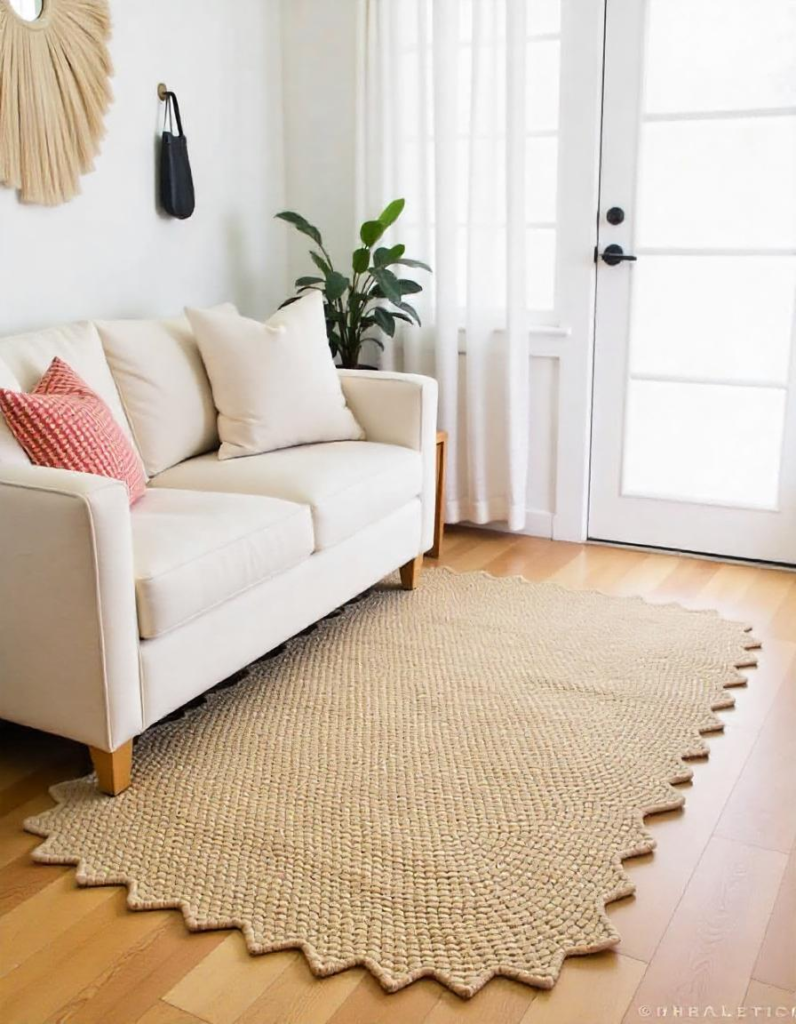
Make your scalloped jute rug truly unique with these personalization ideas:
Monogramming: Stencil or embroider your family initial or monogram in one corner of the rug for a custom touch.
Seasonal Decorations: Add removable seasonal elements, like ribbon weaving for holidays or temporary fabric patches for special occasions.
Embedded Objects: For a truly artistic piece, carefully sew small flat objects like buttons, shells, or decorative coins along the scalloped edges or in patterns across the rug.
Appliqué Work: Create or purchase fabric appliqués and attach them to your jute rug for added color and design interest.
Repair Techniques
Extend the life of your scalloped jute rug with these repair methods:
Edge Reinforcement: If the scalloped edges begin to fray, reinforce them by stitching a matching ribbon or fabric tape along the underside.
Fiber Mending: For small holes or tears, use jute twine and a large needle to stitch the damaged area closed, following the original weave pattern as closely as possible.
Backing Repair: If the backing becomes damaged, apply iron-on backing tape or hand-stitch a patch of canvas to the affected area.
Re-Scalloping: When edges become severely worn, consider trimming and re-scalloping them using the original pattern as a guide. After cutting, secure the new edge with a whipstitch in matching thread.
Conclusion
Scalloped jute rugs represent a perfect marriage of natural materials and thoughtful design, offering homeowners a versatile, eco-friendly, and aesthetically pleasing flooring option. Their unique combination of rustic texture and elegant scalloped edges makes them suitable for virtually any interior style, from coastal casual to sophisticated modern.
